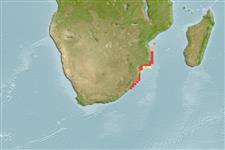Elasmobranchii (sharks and rays) >
Rajiformes (Skates and rays) >
Rajidae (Skates)
Etymology: Dipturus: Greek, di = two + Greek, pteryx = fin (Ref. 45335).
Eponymy: Dr George Gordon Campbell (1893–1977) was a South African physician and naturalist who inspired the Foundation for Marine Biological Research and was President of it, for which he was honoured in the name of the skate. [...] (Ref. 128868), visit book page.
Environment: milieu / climate zone / depth range / distribution range
Ecology
Marine; demersal; depth range 137 - 403 m (Ref. 5578). Subtropical; 20°S - 31°S, 30°E - 38°E (Ref. 114953)
Western Indian Ocean: off central Mozambique to Durban, South Africa.
Size / Weight / Age
Maturity: Lm ? range ? - ? cm
Max length : 66.0 cm TL male/unsexed; (Ref. 5578)
Short description
Identification keys | Morphology | Morphometrics
A black-spotted longnose skate with an elongated, acutely triangular snout, and a stout tail- just shorter than body and slightly swollen along the mid-section; disc with rounded corners and smooth underside except for small denticles on edges and tip of snout; small thorns on nape and midback to 1st dorsal fin (Ref. 5578). Medium grey to brownish with numerous small dark spots dorsally; grey with conspicuous black pores ventrally (Ref. 5578).
Found on the bottom of the outer shelf and upper slope (Ref. 5578). Probably caught by trawlers (Ref. 5578).Oviparous (Ref. 50449). Eggs have horn-like projections on the shell (Ref. 205). Males reaches maturity at ca. 57 cm TL, females at ca. 64 cm TL (Ref. 114953)
Life cycle and mating behavior
Maturity | Reproduction | Spawning | Eggs | Fecundity | Larvae
Oviparous, paired eggs are laid. Embryos feed solely on yolk (Ref. 50449). Eggs have horn-like projections on the shell (Ref. 205).
McEachran, J.D. and K.A. Dunn, 1998. Phylogenetic analysis of skates, a morphologically conservative clade of elasmobranchs (Chondrichthyes: Rajidae). Copeia 1998(2):271-290. (Ref. 27314)
IUCN Red List Status (Ref. 130435: Version 2024-2)
Threat to humans
Harmless
Human uses
Tools
Special reports
Download XML
Internet sources
Estimates based on models
Preferred temperature (Ref.
123201): 8.8 - 21.2, mean 14.4 °C (based on 4 cells).
Phylogenetic diversity index (Ref.
82804): PD
50 = 0.5000 [Uniqueness, from 0.5 = low to 2.0 = high].
Bayesian length-weight: a=0.00282 (0.00131 - 0.00604), b=3.25 (3.08 - 3.42), in cm total length, based on LWR estimates for this Genus-body shape (Ref.
93245).
Trophic level (Ref.
69278): 3.8 ±0.6 se; based on size and trophs of closest relatives
Resilience (Ref.
120179): Low, minimum population doubling time 4.5 - 14 years (Fec assumed to be <100).
Fishing Vulnerability (Ref.
59153): Moderate to high vulnerability (46 of 100).
